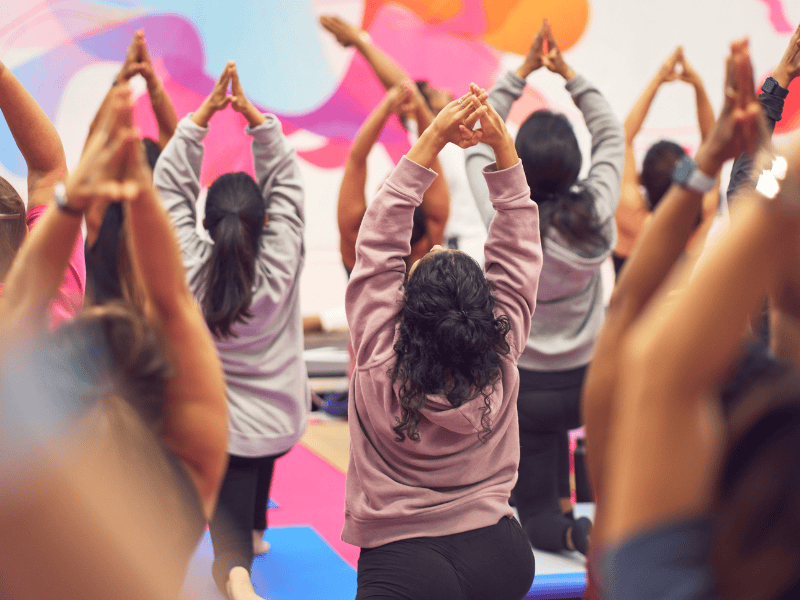HOW TO BUILD A REGULAR YOGA PRACTICE

How to develop a consistent yoga practice
A yoga sequence for supporting consistency in your practice. By Wenche Beard
This practice is designed to awaken your entire body, helping you build strength, flexibility and balance while cultivating a deeper connection to yourself.
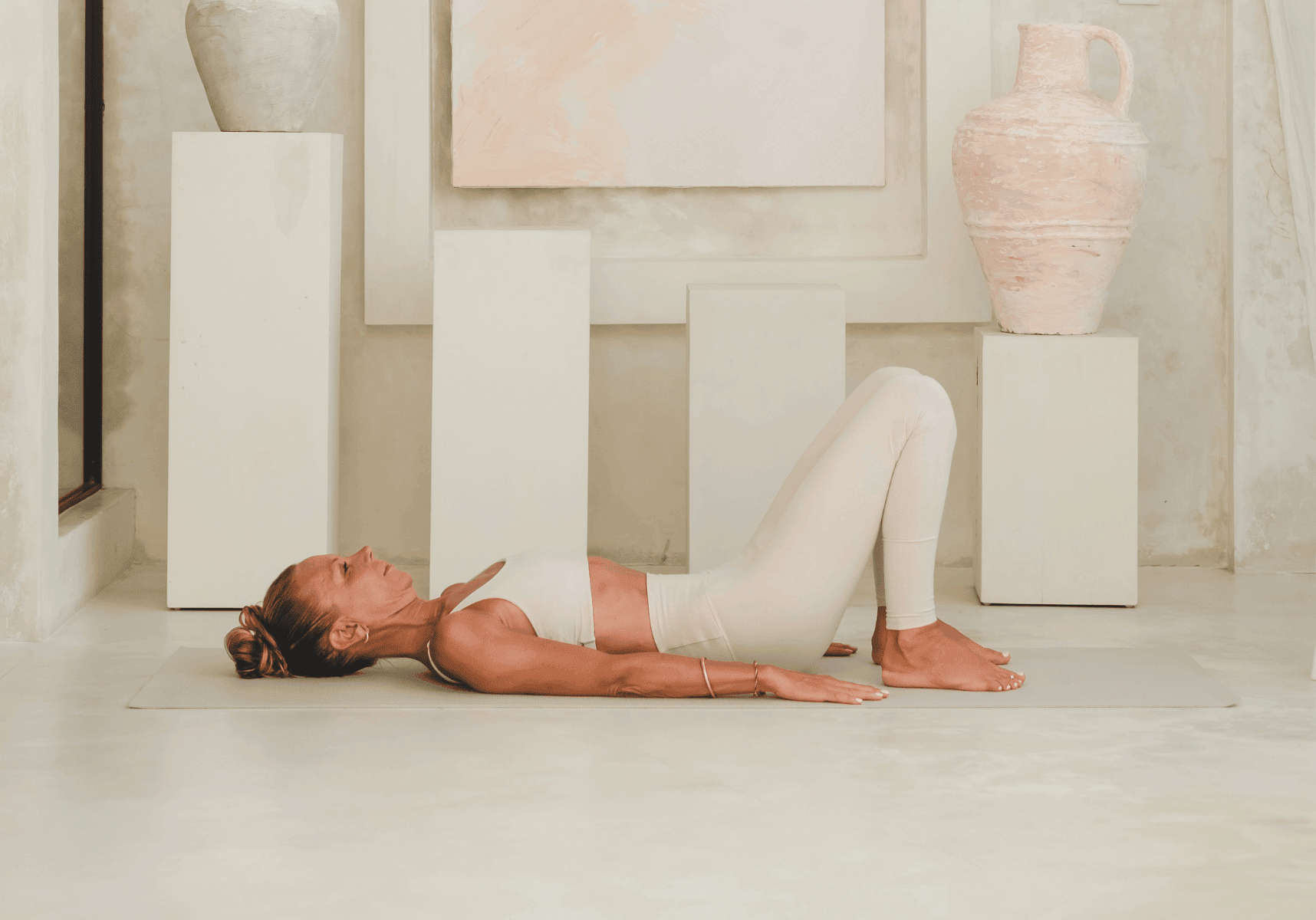
1. Centring On Your Back
Begin your yoga Sadhana journey by lying flat on your back (Supta Tadasana variation). With your knees bent, feet close to your buttocks and arms resting by your sides, make any micro adjustments to get comfortable and settled. Gently tuck your chin toward your chest to lengthen the back of your neck, quieting the mind as you take 3 to 6 deep breaths, inviting the breath all the way into your belly. As you exhale, sigh out, releasing any tension you may have carried onto the mat. Moving fully in this moment, it is your time now. Take a moment and set an intention, your Sankalpa, for this practice as your compass for intentional living. In this posture, you are invited to let go of distractions and connect with your inner self. It’s a moment of surrender and grounding, symbolic of beginning anew.
Benefits:
- Activates the parasympathetic nervous system, calming the mind and body.
- Sets the tone for mindful movement and introspection.
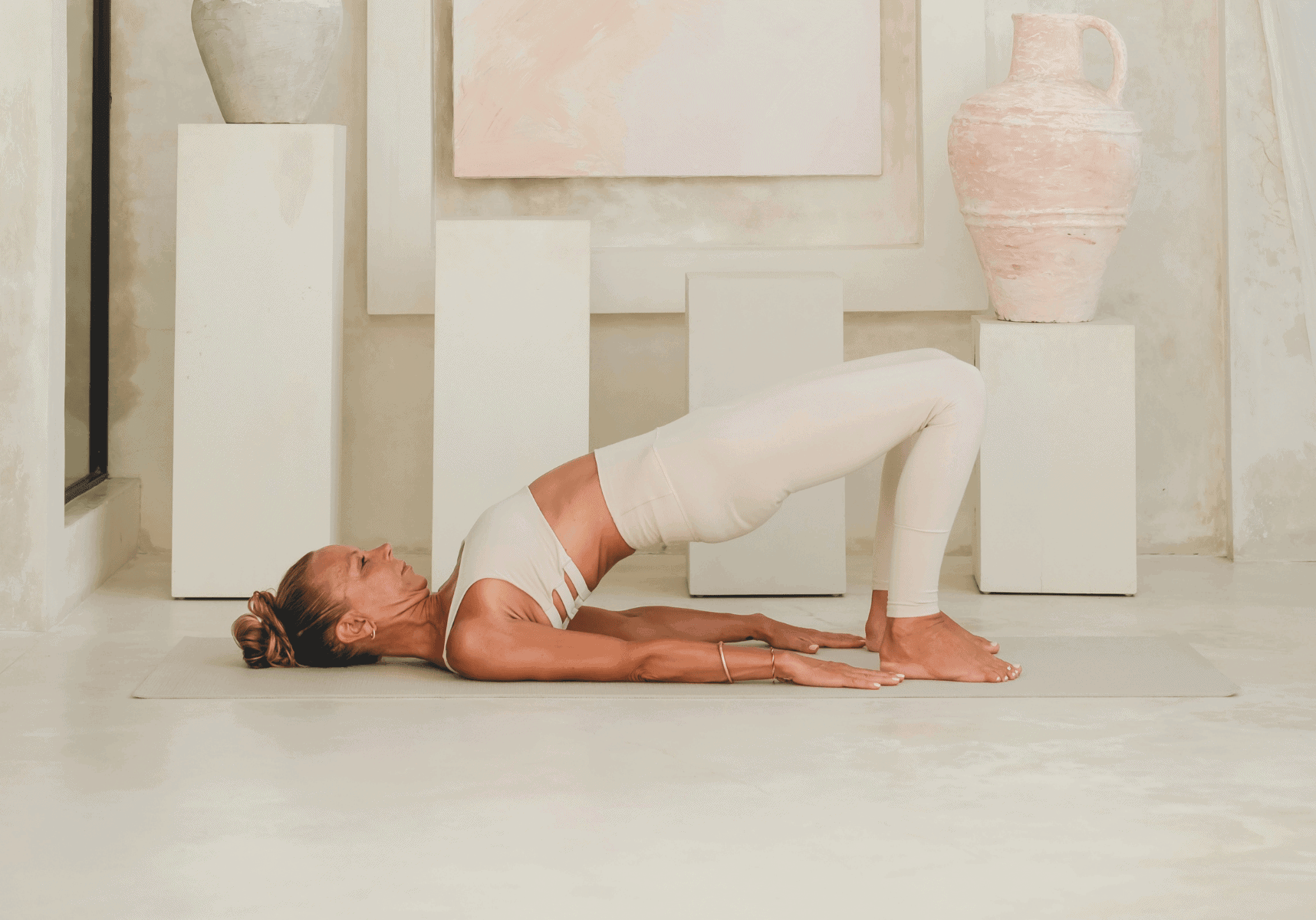
2. Bridge Pose (Setu Bandhasana)
Mindfully moving into this powerful pose, bridging the physical and spiritual self. This pose represents bridging — to create union — and can be related to many aspects of yourself and life. What are you bridging today? Inhale, and slowly peel your spine off the mat, starting from the tailbone. Press into your feet and engage your legs as you float your hips to the sky. Ground the back of your shoulders and arms into the earth for support. Broaden your collarbones like wings and soften your face. Exhale, and slowly roll your spine down, vertebra by vertebra, back to the mat. Repeat dynamically for 3 to 6 rounds. For a variation, hold the bridge shape for a few breaths, then release. Bridge pose also symbolises the connection between effort and ease. As you rise and fall with the breath, you are reminded of the cyclical nature of life and the balance between grounding and uplifting energies.
Benefits:
- Strengthens the legs, glutes, and lower back.
- Stimulates the heart and improves circulation.
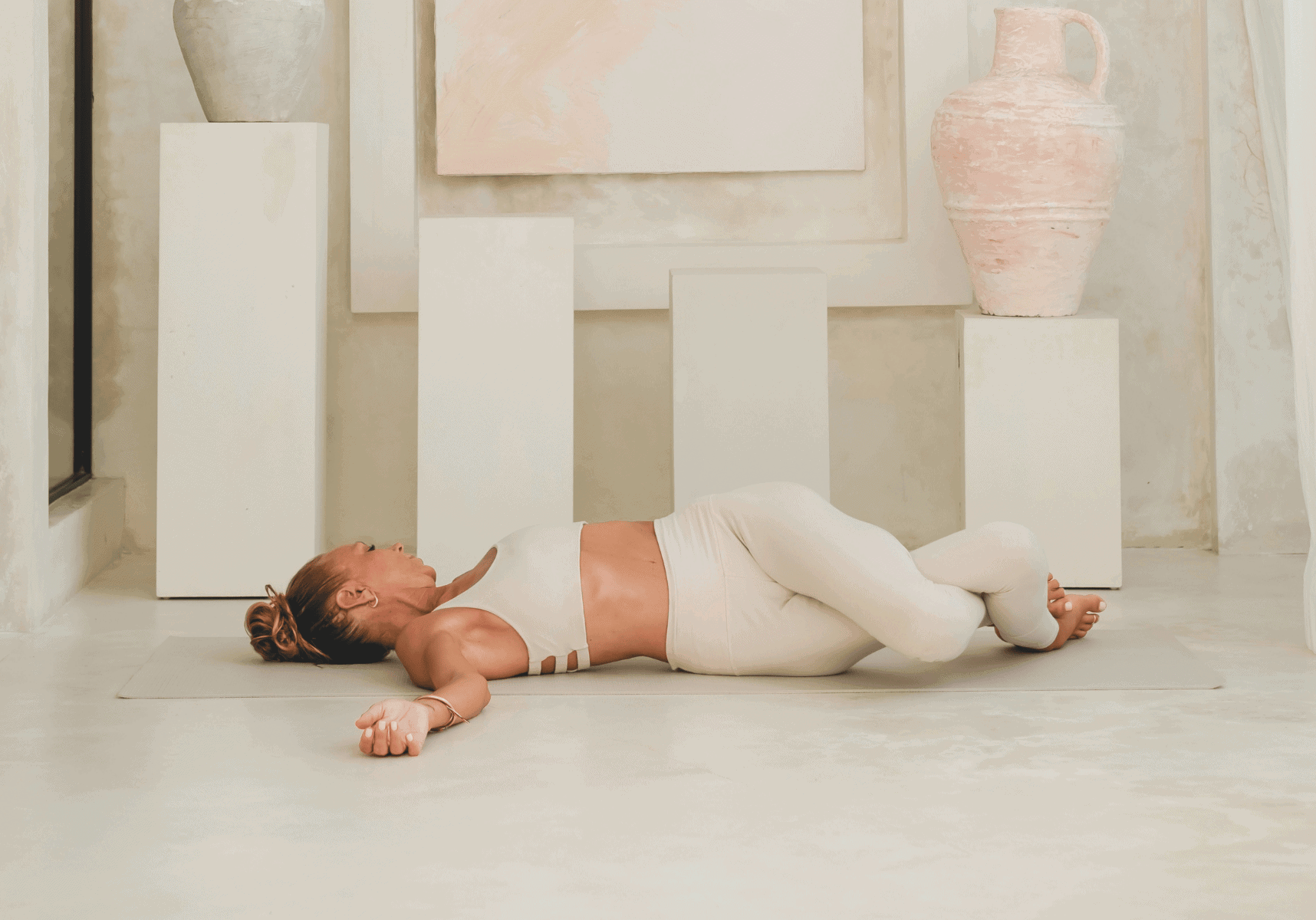
3. Reclining Eagle Twist (Supta Parivrtta Garudasana)
Eagle pose represents the commitment of staying present in challenges and not losing focus on the goal. We can draw upon the eagle’s teachings in this more restorative variation and understand that in challenging times we may need support. Extend your arms out to the sides like wings, palms facing up, knees bent, feet on the floor. Intertwine your legs (left leg over the right). As you exhale, guide your knees gently to your right side, feeling a twist through your spine. Your head gently rolls heavy and relaxed over your left shoulder. Soften here for 3 to 6 breaths and come back to the centre with a strong core, change the intertwine of your legs and repeat on the other side. Twists symbolise release and renewal. As you wring out physical tension, you create space for new energy and clarity to flow.
Benefits:
- Releases tension in the lower back and spine.
- Stimulates digestion and detoxification.
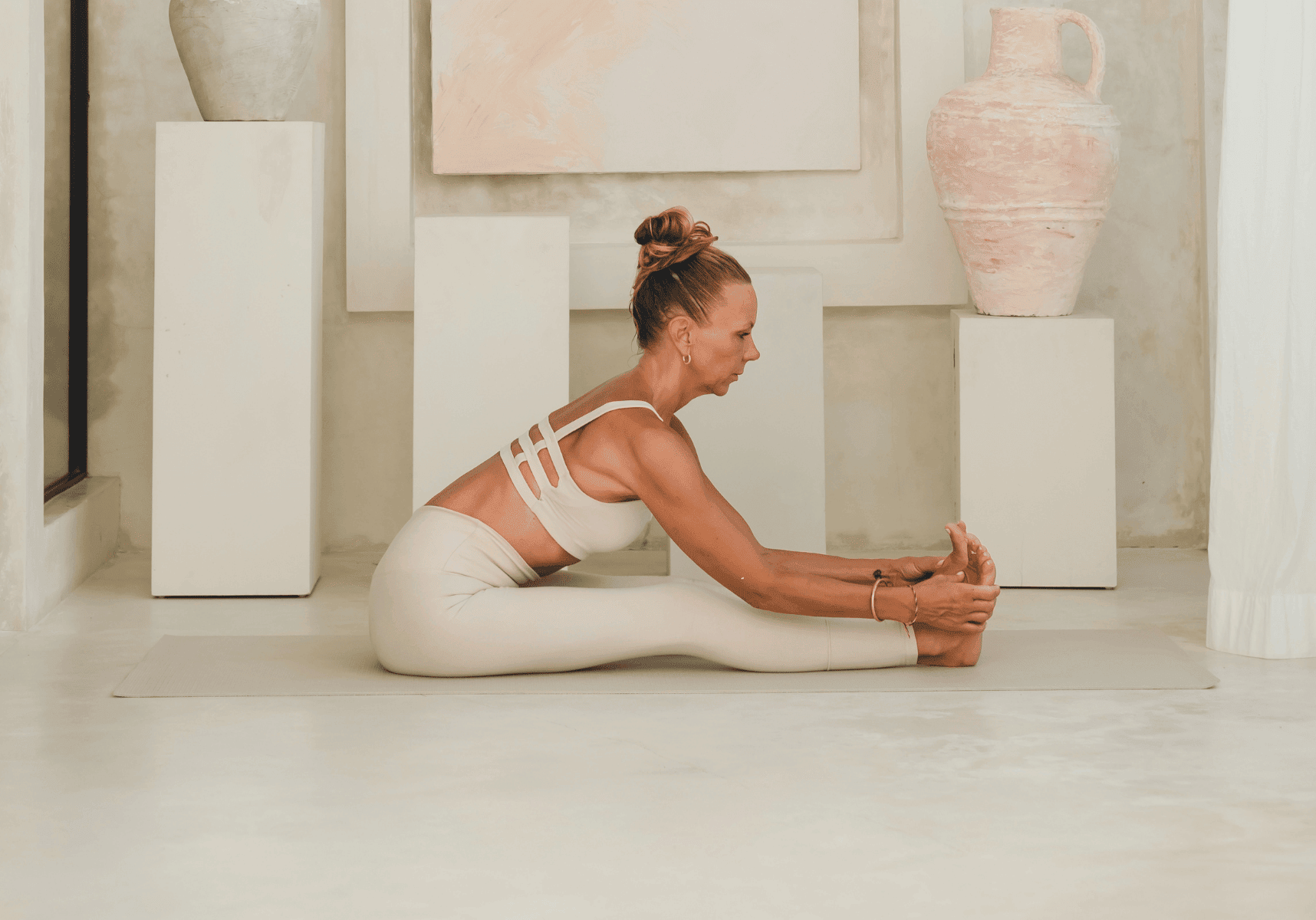
4. Seated Forward Fold (Paschimottanasana)
One of the oldest postures in yogic history, this holds the broad meaning of ‘intense stretch to the west’. What does this mean? West points to the sunset and represents the point of turning inward for the deeper meaning. Sit with your legs extended forward, feet flexed and spine tall, arms by the side of the body (dandasana). Inhale to lengthen through your spine and float your arms to the sky lifting the heart and gaze to the horizon. Exhale, fold forward from your hips, spine moving over your legs towards your feet. Rest your hands where you are comfortable. Keep your spine long and avoid rounding your back. Stay for 3 to 6 breaths as your awareness is now turning inwards. Open your inner eyes and ears to guidance. This pose embodies humility and introspection. Folding inward is a gesture of surrender, inviting you to turn your focus toward your inner world.
Benefits:
- Stretches the hamstrings, calves, and spine.
- Calms the mind and relieves stress.
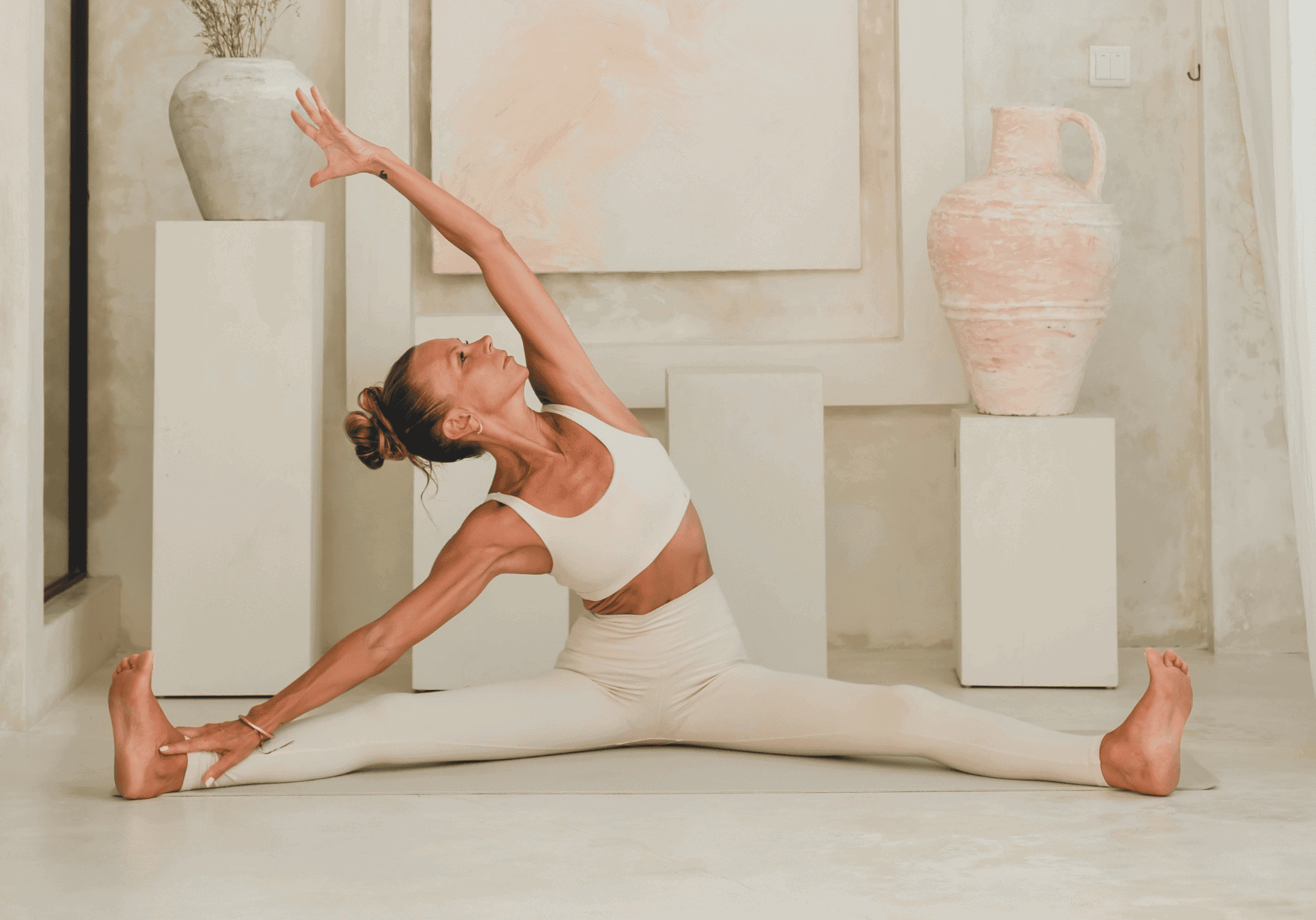
5. Revolved Seated Side Stretch (Parivrtta Parsva Upavistha Konasana Variation)
A graceful pose with an invitation to explore expansiveness, maintaining stability through our foundation. This pose teaches us to open from the inside out and could help us to reveal a new outlook on life. Sit with your legs wide apart, toes pointing upward, spine long. Inhale, reach your right arm towards the sky. Exhale and lean over to the right side, expanding in all directions from the inside as you spiral your heart to the sky. Feel the deep stretch through your left side. Stay for 3 to 6 breaths as you explore the internal effect on opening from the inside reaching your full expression of this pose. Inhale to return to centre and repeat on the other side. Side stretches symbolise expansion. They encourage you to explore the boundaries of your body and mind, expanding into new possibilities.
Benefits:
- Opens the side body and stretches the obliques and intercostal muscles.
- Improves spinal flexibility and balance.
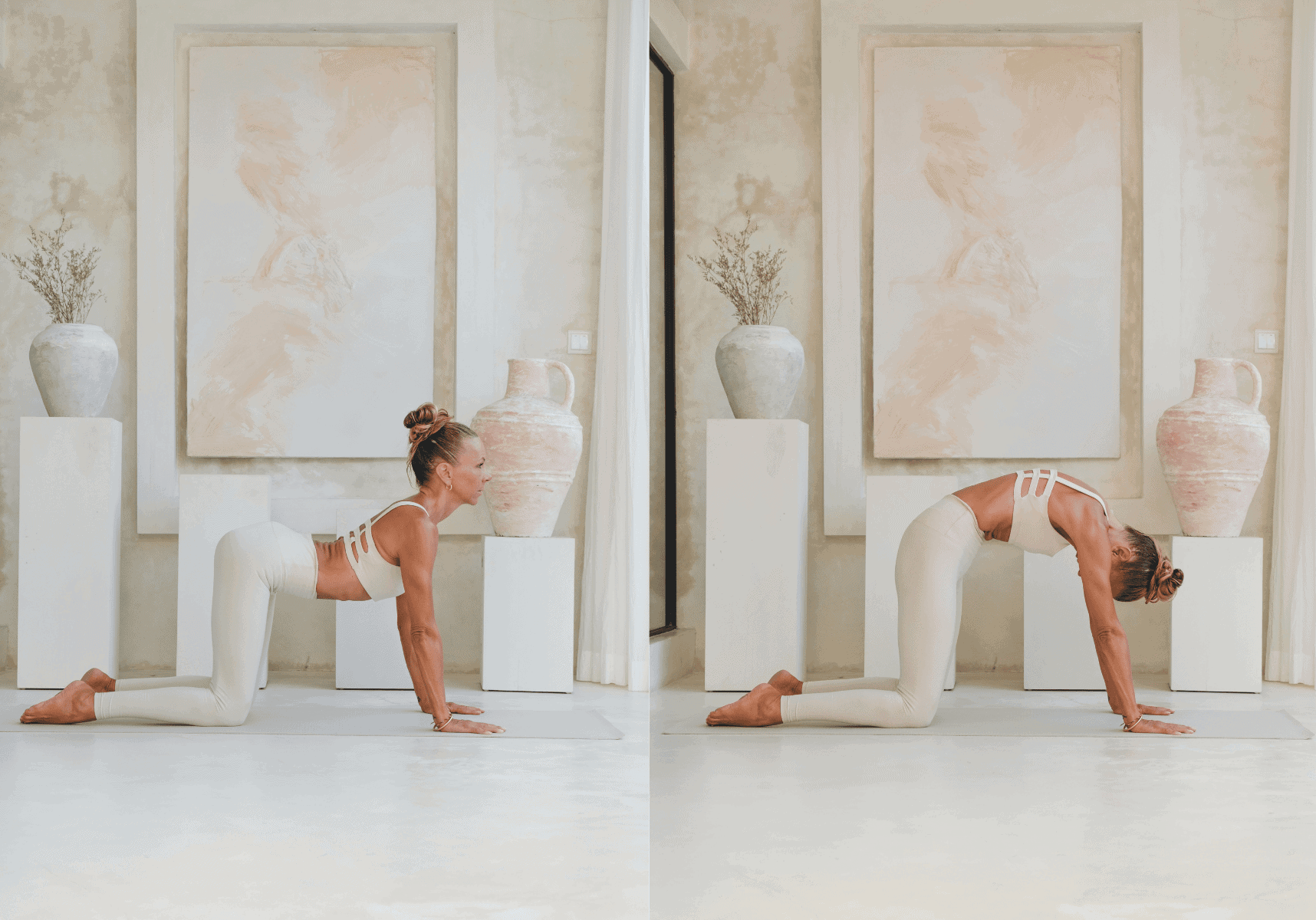
6 & 7. Cat-Cow Flow (Marjaryasana & Bitilasana)
These postures combined enhance the moving meditation that yoga really is. Synchronising breath and movement between these postures enhances curiosity to the mystery, both in the inner and outer world. Begin on all fours with your hands under your shoulders and knees under your hips in tabletop position. Inhale as you lift your tailbone to the sky, drop your belly to the earth and shine your heart forward, head follows gaze steady (Cow). Exhale dropping the tailbone down towards the earth, round your spine by drawing the navel to the spine, tuck your chin in gazing towards the navel (Cat). Flow with your breath for 3 to 6 rounds moving each vertebrae like pearls on a string exploring the marriage of breath and movement. This flow reflects the balance of opposing forces — flexion and extension, effort and release — reminding us that balance is found through movement and rhythm.
Benefits:
- Warms up the spine and improves mobility.
- Massages the internal organs, promoting digestion and circulation.
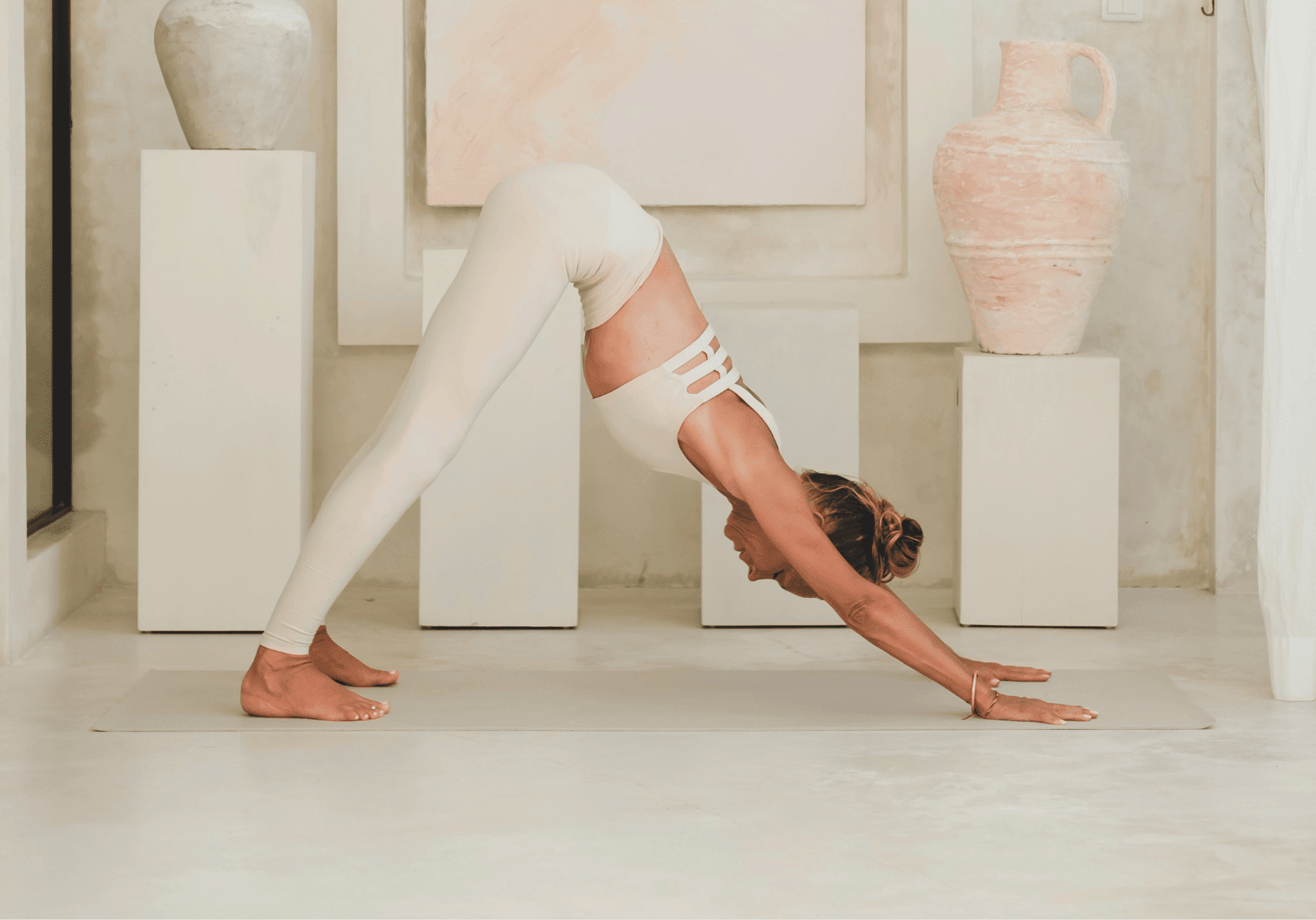
8. Downward Dog (Adho Mukha Svanasana)
This pose is an invitation to taste the sweetness of both strength and surrender. Approaching this with an open mind can help you to explore the smallest shifts and have profound effects. Staying strong and grounded in this pose with a quiet mind supports an internal bond with yourself. From all fours (tabletop), tuck your toes under and float your hips upward grounding your hands and feet into the mat creating an inverted ‘V’ shape with your body. Keep your knees slightly bent if needed and focus on lengthening your spine. Stay here for 3 to 6 breaths as you draw the navel to the spine, release equally through your waist and lift your tail towards the sky. Create space between your shoulders by pressing the edges of your little fingers towards the edge of the mat and release your head. This pose symbolises surrender and stability, a moment to pause, ground yourself and find strength in stillness.
Benefits:
- Strengthens the arms, shoulders, and legs.
- Lengthens the spine and releases tension.
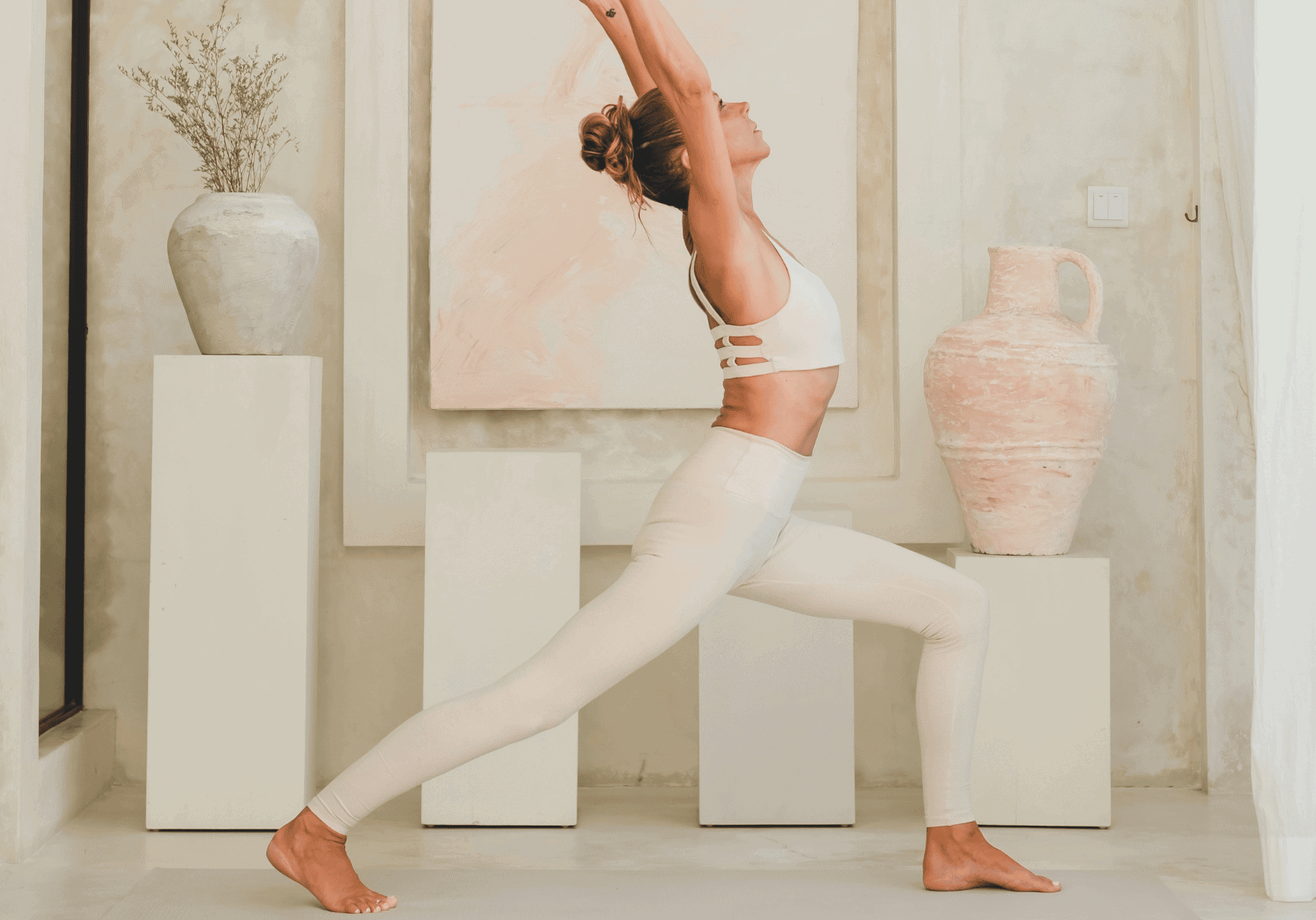
9. Warrior I (Virabhadrasana I)
This pose holds a strong quality of courage, focus and confidence that leads to the celebration of newfound strength. It symbolises the ability to overcome the ego, understanding that difficulties and challenges make us stronger. Step one foot forward into a lunge, with your back heel grounded and toes slightly angled out. Bend your front knee, align it over your ankle, hips square to the front of your mat. Inhale and reach your arms strong overhead finding a firm gaze keeping your back leg strong and engaged. Hold for 3 to 6 breaths, then switch sides. Warrior I invites you to step into your power and embody courage. It’s a pose of strength, resilience, and purposeful action.
Benefits:
- Strengthens the legs, core, and shoulders.
- Builds confidence and focus.
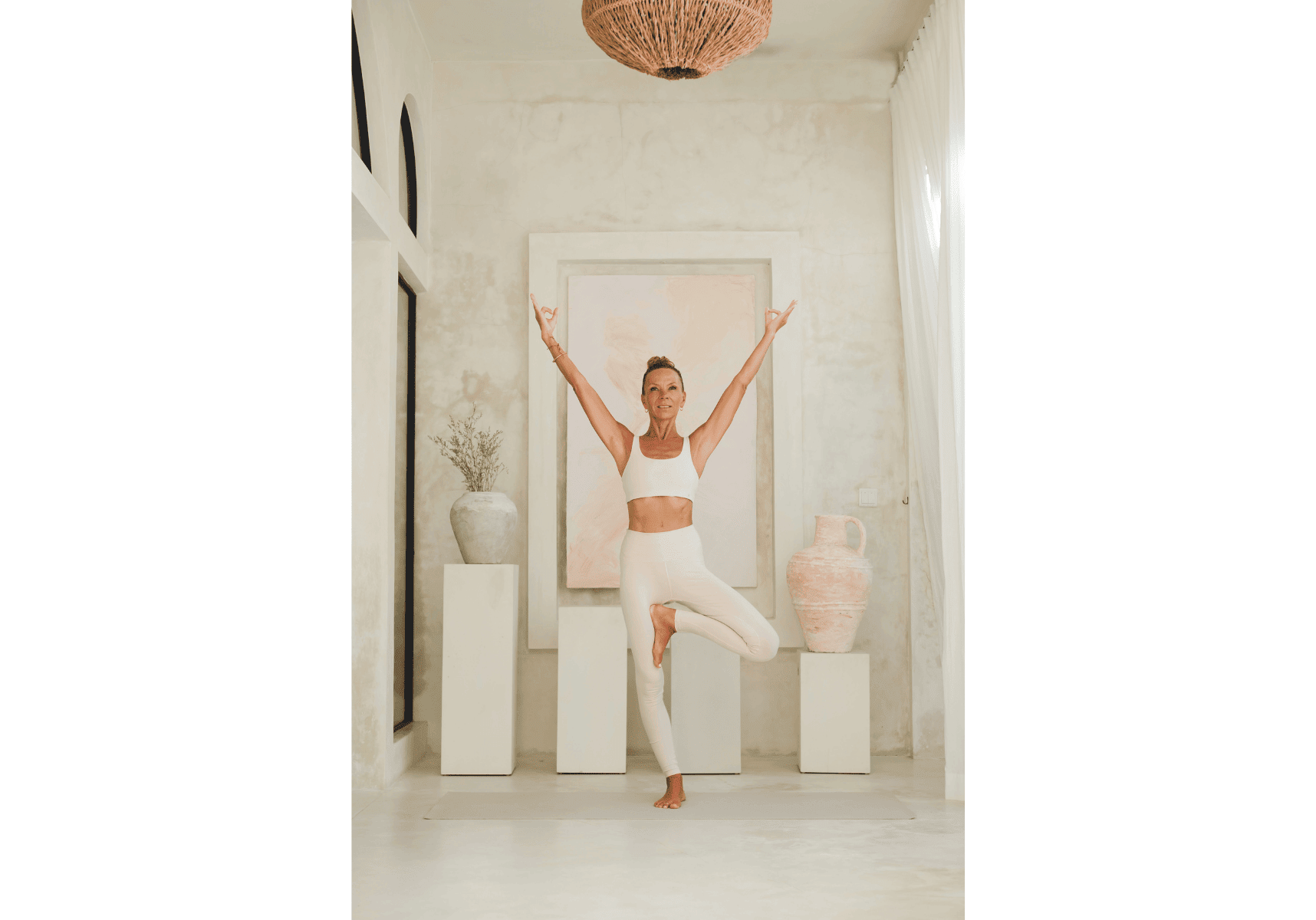
10. Tree Pose (Vrikshasana)
Deeply rooted in yogic philosophy this pose teaches us the importance of balancing body, mind and spirit. The tree pose gives us insight into the importance of being fully rooted and grounded to grow. Keeping the balance takes constant work teaching us patience as we move through the seasons of our lives. Stand tall and present in Tadasana (mountain pose), imagining roots growing from the soles of your feet into the earth. Place one foot on your inner thigh or calf (avoid the knee). Bring your palms together at your heart and find your balance, slowly reach your arms towards the sky on an inhalation. Keep your standing leg engaged and find a focal point to help with balance. Stay for 3 to 6 breaths, repeat on the other side. Tree pose represents rootedness and growth. It teaches us to stay grounded while reaching upward toward our goals and aspirations.
Benefits:
- Improves balance and stability.
- Strengthens the legs and core while promoting focus.
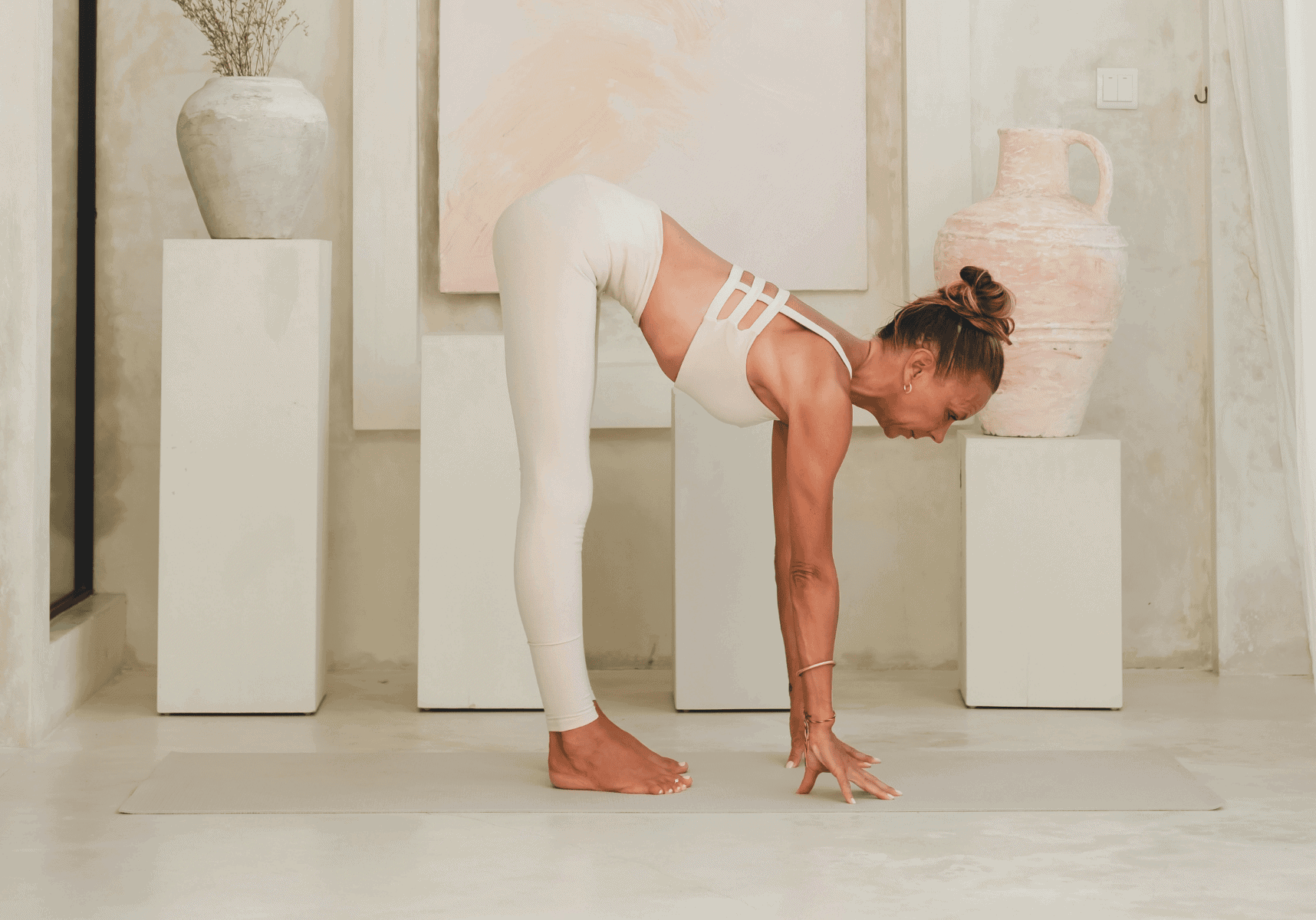
11. Forward Fold With Flat Back (Ardha Uttanasana)
An intense pose that can be deceived by the eye, It looks simple but holds power. You get a satisfying stretch through the whole body but also a calm mind. This pose also teaches us that it's not about ‘touching our toes’, but the journey. From standing (Tadasana) inhale and reach your arms to the sky, engage your core slightly to support length in the spine. Exhale hinge at your hips and fold forward with a long spine, resting your hands on the floor (your shins or thighs) and gaze forward slightly. This pose is a moment of reflection and balance, combining strength with surrender. It invites you to pause and realign with your inner centre.
Benefits:
- Stretches the hamstrings and spine.
- Encourages mindfulness and grounding.
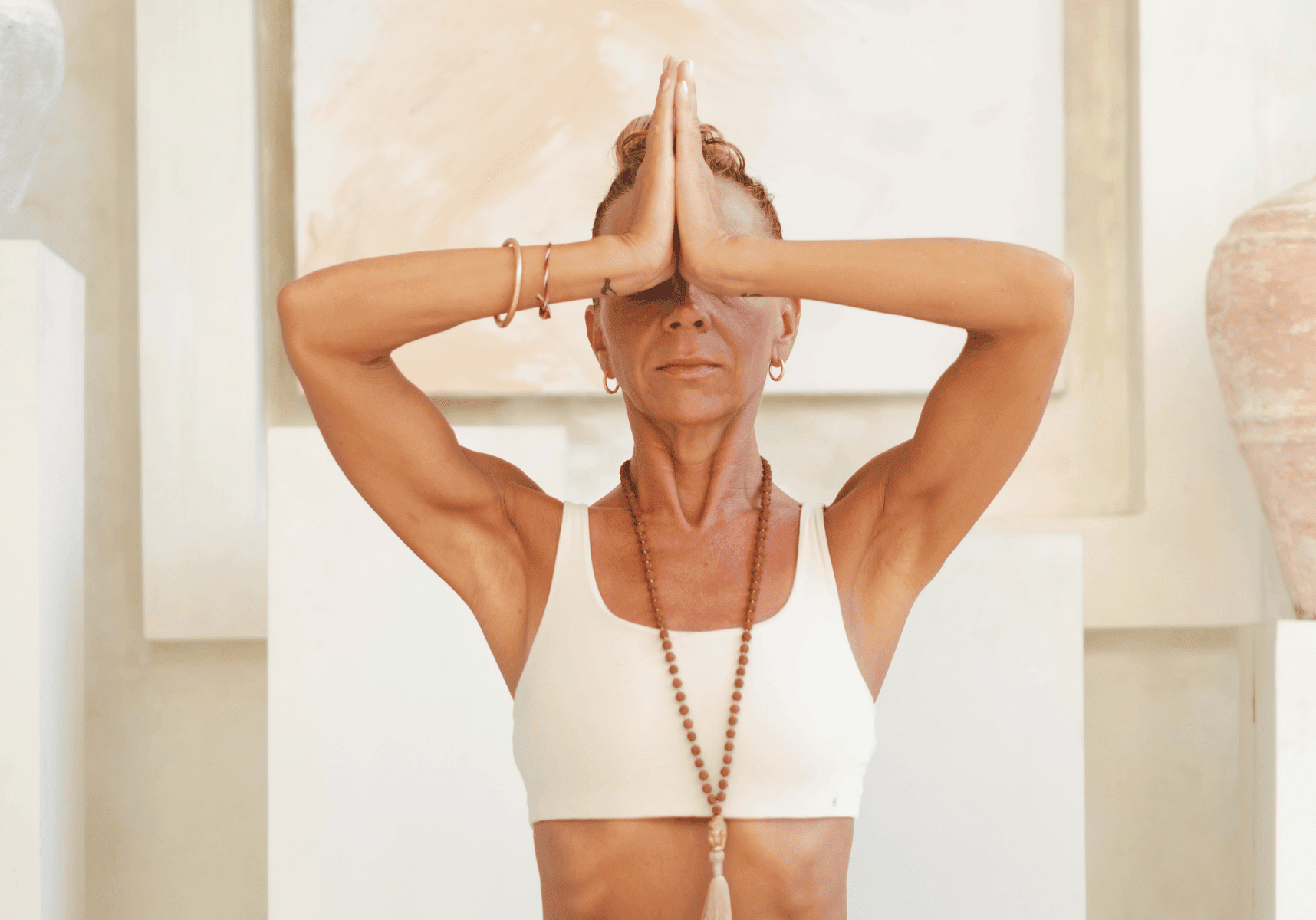
12. Sealing your Practice in Sukhasana
Take a comfortable seat in Sukhasana (Easy Pose), crossing your legs and grounding your sitting bones into the mat. Rest your hands on your knees or thighs, palms facing up in a gesture of receptivity. Lengthen your spine, gently draw your shoulders away from your ears, and lift the crown of your head toward the sky.
Bring your palms together in Anjali Mudra (Namaste) at your heart centre. Close your eyes and take a few deep breaths, softening your face and releasing any lingering tension and open fully to feel the benefits of your Sadhana into your being.
Lift your Anjali Mudra to rest gently at your third eye (the space between your eyebrows).
Take a moment here to revisit your Sankalpa—your intention for this practice. Whether it was grounding, self-love, strength, or surrender, acknowledge how this intention has guided you through your movement and breath. Notice how it feels within you now, as though it has taken root.
Take a Moment of Reflection
Feel into the shift within you—how your body feels lighter, your breath freer, your mind clearer. This is the gift of yoga: a mirror reflecting your true self, free from distraction or doubt. In this moment, open yourself to seeing yourself clearly, with love and compassion.
Closing Affirmation
Silently or aloud, affirm:
“I honour this time I have given myself. I honour my intention and carry it forward with me into my day. May I continue to see myself with clarity, live with purpose, and share this peace with the world.”
Gently release your hands and rest them back on your knees. Slowly lift your gaze, letting the light of the present moment return. Your practice is now sealed, yet its energy stays with you. Namaste.
Through consistent practice, these poses create a foundation for strength, flexibility, and inner peace. Approach your practice with patience and presence — every moment on the mat is an opportunity to grow.
Wenche Beard is founder of Living Yoga Community (livingyogacommunity.com)




